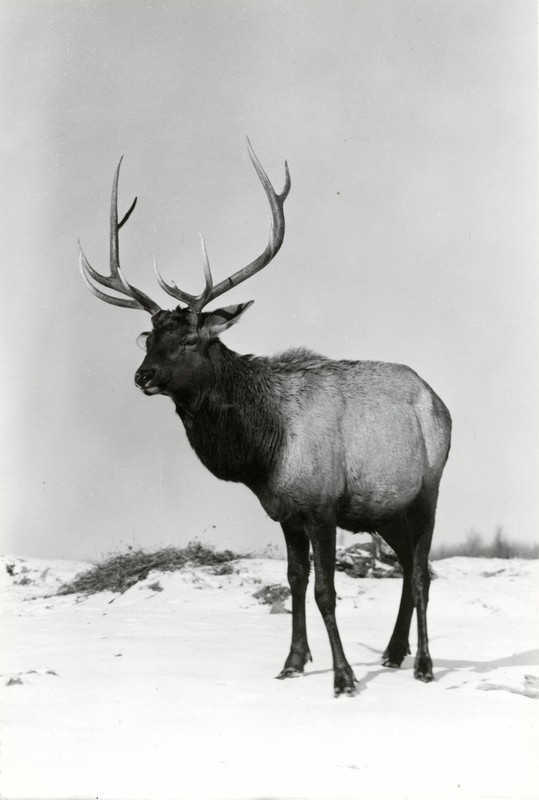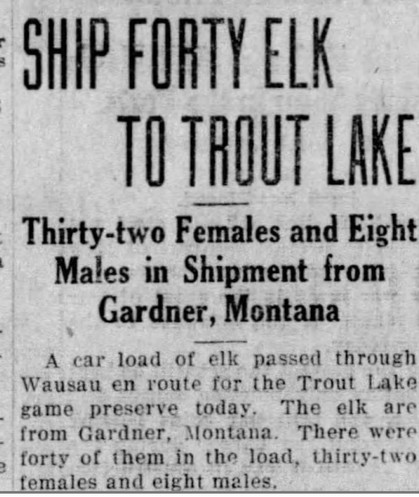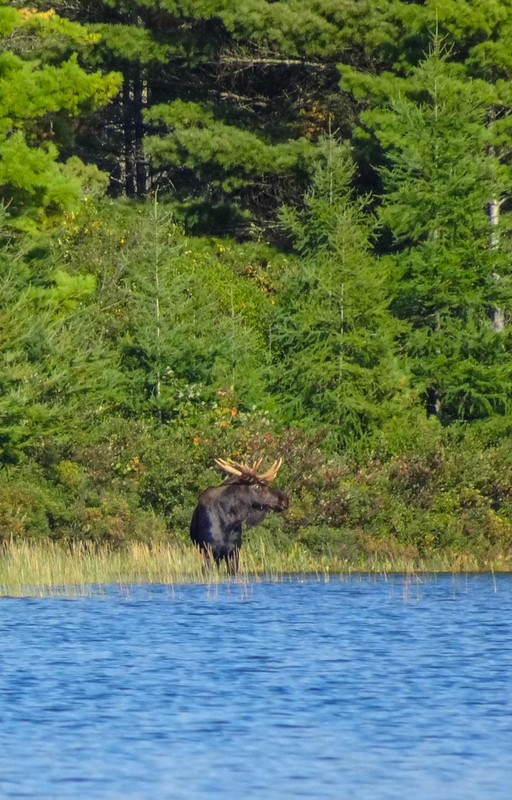Trout Lake Game Farm
Introduction
Text-to-speech Audio
At the start of the 20th century, Wisconsin Progressive policies created a Forestry Headquarters on Trout Lake to ensure Northwoods resources would be scientifically managed for future generations. In 1912, a game farm was created on the Trout Lake campus to protect and restore Wisconsin historic game populations. Ultimately, the game farm was dedicated to reintroducing elk, which proved to be difficult and expensive. This game farm was located on 300 acres between Allequash and Trout lakes. Those wishing to drive into the old game farm need to take Allequash Lake Road off of County Highway M toward the boat landing.
Images
Game Farm at Trout Lake

Fawns at Trout Lake c1911

Poachers get hurt and caught

Big bull in Land O' Lakes

1917 shipment of 40 elk

Arbor Vitae

Sandy Beach Lake moose 2022

Backstory and Context
Text-to-speech Audio
Foresters, rangers and wardens working at Trout Lake Statehouse discovered numerous abandoned fawns in the course of their early field work, thus inspiring a modest deer farm in circa 1911. Soon, the new Trout Lake Headquarters campus was expanded, creating a game farm area with an enclosed 300 acres within a 10-foot-high fence. Ultimately, as many as 100 abandoned fawns were protected and fed at the Trout Lake State Game Farm.
With high hopes starting in 1913, elk were introduced to Trout Lake from Yellowstone National Park. Only two of the animals in the herd survived from the first box car of 32 elk. Charles Comiskey, owner of major league baseball’s Chicago White Sox, donated to help build a herd.
By 1915, Wisconsin conservation officers also were considering adding moose to the Trout Lake Game Farm. Both elk and moose were plentiful across the Northwoods in the 19th century. Today, a few moose live in Iron County, just 15 miles to the west of the old game farm.. Moose do not cohabitate well with white tail deer due to a nasty and potentially fatal parasite called brain worm that deer carry.
In 1917, another 14 of the 40 newly arrived elk died of pneumonia. By 1928, there were only 19 bulls, 17 cows and nine calves left on the game farm. Two bull elk were later transferred to Wisconsin zoos and the rangers had a difficult time wrangling them into box cars. After 1917, the Trout Lake Game Farm managers learned to move elk in May to avoid climate diseases which had hampered reintroduction efforts.
Maintaining the elk herd was challenging, and hay was shipped in by railroad in the winter. John Christensen, who grew up at Trout Lake, reported that some of the game farm elk were mean and would attack their sleighs as they delivered hay. The bull elk in charge was called a “Kaiser,” but the most troublesome elk was a single horned bull that took delight making mischief.
In 1932, the elk were released from the game farm and roamed Vilas and Oneida counties. These big game animals dominated parts of the woods for decades, with a few animals surviving until the early 1960s. Elk occasionally over browsed the area and sometimes became aggressive with local residents. Arbor Vitae resident Jerry Trapp recalled a bull elk tearing the front steps off of his family’s Arbor Vitae home with its antlers.
Poachers prized elk above other Northwoods game animals. During the Great Depression, poachers from the south had special cars for shooting and preserving wild animal meat. While not all poachers were sophisticated, the Rhinelander Daily News reported in 1934, “Wardens were informed that when the poacher first tried to kill this elk, one of the men emptied his gun at the elk, but the wounded animal attacked him, knocking him unconscious and kicking out two of his teeth before another hunter killed the elk.” A different member of this poaching ring was later arrested for killing deer and ended up in the Vilas County jail.
Sadly, what began as a promising reintroduction of native Wisconsin big game fell to ruin. Importantly, Wisconsin boasts of a thriving elk herd today near Clam Lake and Jackson County.
Sources
Christensen, John A. Northwoods Life. Trout Lake, WI. 2005.
Wisconsin Conservation Commission . Game Farm, January 1st, 1916. Accessed April 15th, 2024. https://search.library.wisc.edu/digital/AFVEYIUOJ2LZYE8B. Page 62-64.
"Four Men Under Arrest; Two in Court." Rhinelander Daily News (Rhinelander ) September 21st, 1934.
"Ship Forty Elk To Trout Lake." Wausau Daily Herald (Wausau ) February 17th, 1917.
Wisconsin Conservation Commision/DNR
Wisconsin Conservation Commision/DNR
Rhinelander Daily News
Wisconsin Conservation Commision/DNR
Wausau Daily Journal
Wisconsin Conservation Commision/DNR
Jim Cagney
